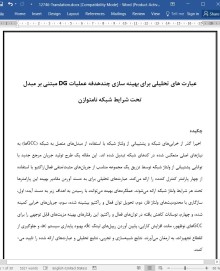
دانلود مقاله عبارت های تحلیلی برای بهینه سازی چندهدفه عملیات DG مبتنی بر مبدل تحت شرایط شبکه نامتوازن
چکیده
اخیرا گذر از خرابی های شبکه و پشتیبانی از ولتاژ شبکه با استفاده از مبدل های متصل به شبکه (GCCها) به نیازهای اصلی منعکس شده در کدهای شبکه تبدیل شده اند.. این مقاله یک طرح تولید جریان مرجع جدید با توانایی پشتیبانی از ولتاژ شبکه توسط تزریق یک مجموعه مناسب از جریان های مثبت/منفی فعال/راکتیو با استفاده از چهار پارامتر کنترل کننده را ارائه می کند. عبارت های تحلیلی برای به دست آوردن مقادیر بهینه این پارامترها تحت هر شرایط ولتاژ شبکه ارائه می شوند. عملکردهای بهینه می توانند با رسیدن به اهداف زیر به دست آیند: اول، سازگاری با محدودیت های ولتاژ فاز، دوم، تحویل توان فعال و راکتیو بیشینه شده، سوم، جریان های خرابی کمینه شده، و چهارم، نوسانات کاهش یافته در توان های فعال و راکتیو. این رفتارهای بهینه مزیت های قابل توجهی را برای GCCهای نوظهور، مانند افزایش کارایی، پایین آوردن ریپل های لینک dc، بهبود پایداری سیستم ac، و جلوگیری از انقطاع تجهیزات، به ارمغان می آورند. نتایج شبیه سازی و تجربی، نتایج تحلیلی و عبارت های ارائه شده را تایید می کنند.
1- مقدمه
نفوذ بالای منابع انرژی تجدیدپذیر و واحدهای تولید پراکنده (DG) در سیستم های قدرت نگرانی های جدی را درباره پایداری ایجاد کرده است. درنتیجه، برنامه ریزان سیستم نیازمندی های دقیقی را برای عملیات مبدل های متصل به شبکه (GCCها) تحت شرایط شبکه غیرعادی ایجاد کرده اند [1-3]. بر این اساس، GCCها نه تنها باید چنین اختلالاتی را تحمل کرده و به تغذیه شبکه ادامه دهند، بلکه باید پشتیبانی های ولتاژ/فرکانسی را نیز فراهم کنند. سازگاری GCCها با این نیازمندی های جدید به طور گسترده در مقالات، برای مثال، در [1-20] مطالعه شده است. در این زمینه، راهبردهای کنترل بسیاری برای GCCها در [13-20] ارائه شده اند.
7- نتیجه گیری
این مقاله طرح های تولید جریان مرجع بهینه را توسط تزریق یک مجموعه مناسب از جریان های فعال/راکتیو مثبت/منفی با استفاده از چهار پارامتر کنترل کننده ارائه کرد. عبارت های تحلیلی برای یافتن مقادیر بهینه این پارامترها تحت هر شرایط ولتاژ شبکه ارائه شدند. هدف طرح های ارائه شده تنظیم ولتاژهای سه فاز، کمینه سازی نوسان های توان، کمینه سازی جریان های خرابی، و بیشینه کردن تحویل توان، تحت شرایط ولتاژ پایین و نامتوازن می باشد. این عملکردهای بهینه مزیت های قابل توجهی در افزایش سطح نفوذ GCCها، مانند بهبود کارایی آن ها، پایین آوردن ریپل های لینک dc، افزایش پایداری سیستم ac، سازگاری با کدهای شبکه دقیق، و جلوگیری از انقطاع تجهیزات، دارند. نتایج موفقیت آمیز طرح های ارائه شده با استفاده از نتایج آزمایش شبیه سازی و تجربی تایید شدند.
Abstract
Recently, riding through grid faults and supporting the grid voltage by using grid-connected converters (GCCs) have become major requirements reflected in the grid codes. This paper presents a novel reference current generation scheme with the ability to support the grid voltage by injecting a proper set of positive/negative active/reactive currents by using four controlling parameters. Analytical expressions are proposed to obtain the optimal values of these parameters under any grid voltage condition. The optimal performances can be obtained by achieving the following objectives: first, compliance with the phase voltage limits, second, maximized active and reactive power delivery, third, minimized fault currents, and fourth reduced oscillations on the active and reactive powers. These optimal behaviors bring significant advantages to emerging GCCs, such as increasing the efficiency, lowering the dc-link ripples, improving ac system stability, and avoiding equipment tripping. Simulation and experimental results verify the analytical results and the proposed expressions.
I. INTRODUCTION
THE increasingly high penetration of renewable energy resources and distributed generation (DG) units into power systems has created serious stability concerns. Consequently, system planners have been developing rigorous requirements for grid-connected converters (GCCs) operation under abnormal grid conditions [1]–[3]. Accordingly, GCCs should not only withstand such disturbances and keep feeding the grid, but also provide voltage/frequency supports. The compliance of GCCs with these new requirements has been extensively studied in the literature, as, for instance, in [1]–[20]. In this regard, many control strategies for GCCs have been proposed in [13]–[20].
This paper uses, then modifies, the most advanced reference current generator (RCG) strategy (introduced in [3]), which can flexibly contain positive/negative and active/reactive currents. This RCG offers valuable voltage support services with two controlling parameters, kp and kq , balancing between the positive and negative sequences of the corresponding active and reactive currents. As well, the reference values for the active and reactive powers (P∗ and Q∗) can be considered as other two reference values.
VII. CONCLUSION
This paper presented optimal reference current generation schemes by injecting a proper set of positive/negative active/reactive currents using four controlling parameters. Analytical expressions were proposed to find the optimal values of these parameters under any grid voltage condition. The proposed schemes aim to regulate the three-phase voltages, minimize power oscillations, minimize fault currents, and maximize power delivery, under low-voltage and unbalanced condition. These optimal performances have substantial advantages in increasing the penetration level of GCCs, such as improving their efficiency, lowering dc-link ripples, increasing ac system stability, complying with stringent grid codes, and avoiding equipment tripping. The successful results of the proposed schemes were verified using simulation and experimental test results.
چکیده
1- مقدمه
2- ارزیابی ریاضی راهبرد RCG
3- طرح های پشتیبانی بهینه پیشنهادی
4- طرح پشتیبانی ولتاژ و تحویل توان فعال مجاز ماکزیمم (VSS-MAP)
5- نتایج شبیه سازی
6- نتایج تجربی
7- نتیجه گیری
منابع
Abstract
1. INTRODUCTION
2. MATHEMATICAL ASSESSMENT OF THE RCG STRATEGY
3. PROPOSED OPTIMAL SUPPORT SCHEMES
4. VOLTAGE SUPPORT SCHEME AND MAXIMUM ALLOWABLE ACTIVE POWER DELIVERY (VSS-MAP)
5. SIMULATION RESULTS
6. EXPERIMENTAL RESULTS
7. CONCLUSION
REFERENCES
- ترجمه فارسی مقاله با فرمت ورد (word) با قابلیت ویرایش، بدون آرم سایت ای ترجمه
- ترجمه فارسی مقاله با فرمت pdf، بدون آرم سایت ای ترجمه



